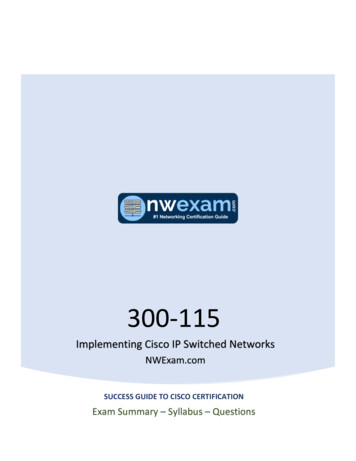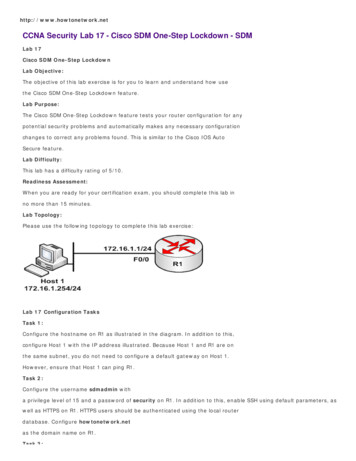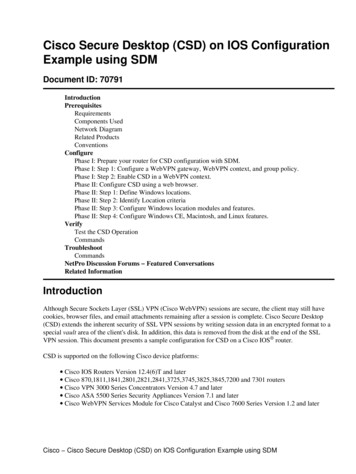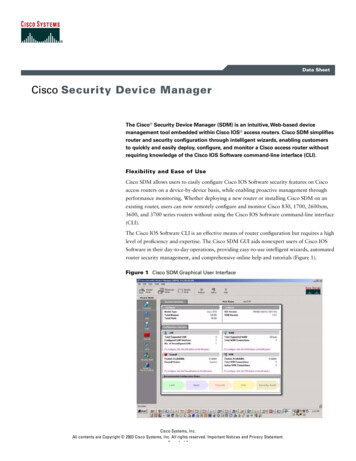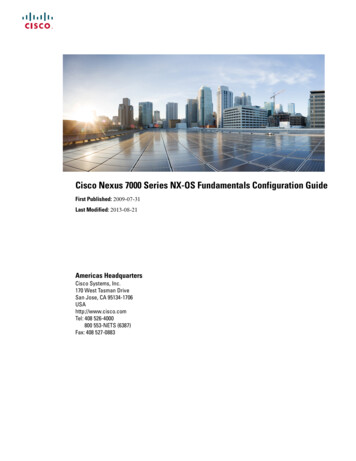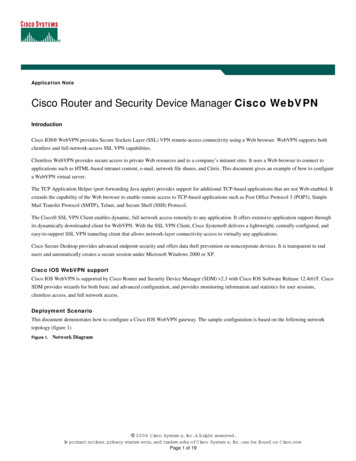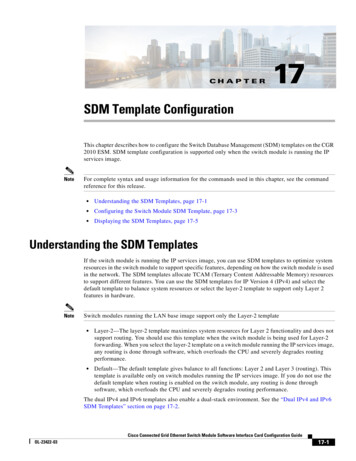
Transcription
CH A P T E R17SDM Template ConfigurationThis chapter describes how to configure the Switch Database Management (SDM) templates on the CGR2010 ESM. SDM template configuration is supported only when the switch module is running the IPservices image.NoteFor complete syntax and usage information for the commands used in this chapter, see the commandreference for this release. Understanding the SDM Templates, page 17-1 Configuring the Switch Module SDM Template, page 17-3 Displaying the SDM Templates, page 17-5Understanding the SDM TemplatesIf the switch module is running the IP services image, you can use SDM templates to optimize systemresources in the switch module to support specific features, depending on how the switch module is usedin the network. The SDM templates allocate TCAM (Ternary Content Addressable Memory) resourcesto support different features. You can use the SDM templates for IP Version 4 (IPv4) and select thedefault template to balance system resources or select the layer-2 template to support only Layer 2features in hardware.NoteSwitch modules running the LAN base image support only the Layer-2 template Layer-2—The layer-2 template maximizes system resources for Layer 2 functionality and does notsupport routing. You should use this template when the switch module is being used for Layer-2forwarding. When you select the layer-2 template on a switch module running the IP services image,any routing is done through software, which overloads the CPU and severely degrades routingperformance. Default—The default template gives balance to all functions: Layer 2 and Layer 3 (routing). Thistemplate is available only on switch modules running the IP services image. If you do not use thedefault template when routing is enabled on the switch module, any routing is done throughsoftware, which overloads the CPU and severely degrades routing performance.The dual IPv4 and IPv6 templates also enable a dual-stack environment. See the “Dual IPv4 and IPv6SDM Templates” section on page 17-2.Cisco Connected Grid Ethernet Switch Module Software Interface Card Configuration GuideOL-23422-0317-1
Chapter 17SDM Template ConfigurationUnderstanding the SDM TemplatesTable 17-1 shows the approximate number of each resource supported in each of the two IPv4 templatesfor a switch module running the IP services image. The values in the template are based on eight routedinterfaces and approximately 1024 VLANs and represent the approximate hardware boundaries set whena template is selected. If a section of a hardware resource is full, all processing overflow is sent to theCPU, seriously impacting switch module performance.Table 17-1Approximate Number of Feature Resources Allowed by Each ast MAC addresses2K8KIPv4 IGMP groups multicast routes (default only)1K0.25 KIP v4 IGMP groups (layer-2 only)1K–IPv4 multicast routes (layer-2 only)0–IPv4 IGMP groups and multicast routes1K–IPv4 unicast routes09K Directly connected IPv4 hosts–5K Indirect IPv4 routes–4K00.5 KIPv4 or MAC QoS ACEs0.5 K0.375 KIPv4 or MAC security ACEs1K0.375 KIPv4 policy-based routing ACEs121. ACEs Access control entries.2. QoS Quality of service.Dual IPv4 and IPv6 SDM TemplatesYou can select SDM templates to support IP Version 6 (IPv6). For more information about IPv6 and howto configure IPv6 routing, see Chapter 39, “Configuring IPv6 Unicast Routing” in the Cisco CGS 2520Software Configuration Guide. For information about configuring IPv6 ACLs, see Chapter 41,“Configuring IPv6 ACLs” in the Cisco CGS 2520 Software Configuration Guide.This software release does not support Policy-Based Routing (PBR) when forwarding IPv6 traffic. Thesoftware supports IPv4 PBR only when the dual-ipv4-and-ipv6 routing template is configured.The dual IPv4 and IPv6 templates allow the switch module to be used in dual stack environments(supporting both IPv4 and IPv6). Using the dual stack templates results in less TCAM capacity allowedfor each resource. Do not use them if you plan to forward only IPv4 traffic.These SDM templates support IPv4 and IPv6 environments: Dual IPv4 and IPv6 default template—supports Layer 2, multicast, routing, QoS, and ACLs forIPv4; and Layer 2, routing, and ACLs for IPv6 on the switch module. Dual IPv4 and IPv6 routing template—supports Layer 2, multicast, routing (including policy-basedrouting), QoS, and ACLs for IPv4; and Layer 2, routing, and ACLs for IPv6 on the switch module. Dual IPv4 and IPv6 VLAN template—supports basic Layer 2, multicast, QoS, and ACLs for IPv4,and basic Layer 2 and ACLs for IPv6 on the switch module.This software release does not support IPv6 multicast routing, IPv6 QoS, or IPv6 Multicast ListenerDiscovery (MLD) snooping.Cisco Connected Grid Ethernet Switch Module Software Interface Card Configuration Guide17-2OL-23422-03
Chapter 17SDM Template ConfigurationConfiguring the Switch Module SDM TemplateNoteAn IPv4 route requires only one TCAM entry. Because of the hardware compression scheme used forIPv6, an IPv6 route can take more than one TCAM entry, reducing the number of entries forwarded inhardware.Table 17-2 defines the approximate feature resources allocated by each dual template. Templateestimations are based on a switch module with 8 routed interfaces and approximately 1000 VLANs.Table 17-2Approximate Feature Resources Allowed by Dual IPv4-IPv6 RoutingIPv4-and-IPv6VLANUnicast MAC addresses8K1K4KIPv4 IGMP groups and multicast routes0.25 K0.5 K1KTotal IPv4 unicast routes:02K0 Directly connected IPv4 hosts-1K- Indirect IPv4 routes-K1K-IPv6 multicast groups0.375 K0.625 K1.125 KTotal IPv6 unicast routes:02.75 K0 Directly connected IPv6 addresses01K0 Indirect IPv6 unicast routes00.625 K0IPv4 policy-based routing ACEs00.125 K0IPv4 or MAC QoS ACEs (total)0.375 K0.375 K0.5 K0.375 K0.125 K0.5 K00.25 K0IPv6 QoS ACEs000.5 KIPv6 security ACEs0.125 K0.25 K0.5 KIPv4 or MAC security ACEs (total)IPv6 policy-based routing ACEs11. IPv6 policy-based routing is not supported.Configuring the Switch Module SDM Template Default SDM Template, page 17-3 SDM Template Configuration Guidelines, page 17-4 Setting the SDM Template, page 17-4Default SDM TemplateThe default template for a switch module running the IP services image is the default template.The default (and only) template supported on switch modules running the LAN base image is the Layer-2template.Cisco Connected Grid Ethernet Switch Module Software Interface Card Configuration GuideOL-23422-0317-3
Chapter 17SDM Template ConfigurationConfiguring the Switch Module SDM TemplateSDM Template Configuration GuidelinesFollow these guidelines when selecting and configuring SDM templates: You must reload the switch module for the configuration to take effect. If you are using the switch module for Layer 2 features only, select the layer-2 template. Do not use the default template if you do not have routing enabled on your switch module. The sdmprefer default global configuration command prevents other features from using the memoryallocated to unicast routing in the routing template. You should use the default template when you plan to enable routing on the switch module. If youdo not use the default template when routing is enabled, routing is done through software, whichoverloads the CPU and severely degrades routing performance. If you try to configure IPv6 features without first selecting a dual IPv4 and IPv6 template, a warningmessage is generated. Using the dual-stack templates results in less TCAM capacity allowed for each resource, so do notuse the dual-stack templates if you plan to forward only IPv4 traffic.Setting the SDM TemplateBeginning in privileged EXEC mode, follow these steps to use the SDM template to select a template ona switch module running the IP services image:StepCommandStep 1Enter global configuration mode.configure terminalStep 2Specify the SDM template to be used on theswitch module:sdm prefer {default dual-ipv4-and-ipv6{default routing vlan} layer-2}The keywords have these meanings: default—Balance all functions. dual-ipv4-and-ipv6—Select a template thatsupports both IPv4 and IPv6 routing.– default—Balance IPv4 and IPv6 Layer 2and Layer 3 functionality.– routing—Provide maximum usage forIPv4 and IPv6 routing, including IPv4policy-based routing.– vlan—Provide maximum usage for IPv4and IPv6 VLANs. layer-2—Support Layer 2 functionality anddo not support routing on the switch module.Step 3Return to privileged EXEC mode.endStep 4Reload the operating system.reloadCisco Connected Grid Ethernet Switch Module Software Interface Card Configuration Guide17-4OL-23422-03
Chapter 17SDM Template ConfigurationDisplaying the SDM TemplatesAfter the system reboots, you can use the show sdm prefer privileged EXEC command to verify the newtemplate configuration. If you enter the show sdm prefer command before you enter the reloadprivileged EXEC command, the show sdm prefer command shows the template currently in use and thetemplate that will become active after a reload.This is an example of an output display when you have changed the template to the layer-2 template andhave not reloaded the switch module:Switch# show sdm preferThe current template is "default" template.The selected template optimizes the resources in the switch to support this level offeatures for 0 routed interfaces and 1024 VLANs.number of unicast mac addresses:8Knumber of IPv4 IGMP groups multicast routes:0.25Knumber of IPv4 unicast routes:9Knumber of directly-connected IPv4 hosts:5Knumber of indirect IPv4 routes:4Knumber of IPv4 policy based routing aces:0.5Knumber of IPv4/MAC qos aces:0.375Knumber of IPv4/MAC security aces:0.375KOn next reload, template will be "layer-2" template.To return to the default template, use the no sdm prefer global configuration command.This example shows how to configure a switch module with the Layer-2 template:Switch(config)# sdm prefer layer-2Switch(config)# endSwitch# reloadProceed with reload? [confirm].Displaying the SDM TemplatesUse the show sdm prefer privileged EXEC command with no parameters to display the active template.Use the show sdm prefer [default dual-ipv4-and-ipv6 {default routing vlan} layer-2] privilegedEXEC command to display the resource numbers supported by the specified template.This is an example of output from the show sdm prefer command, displaying the template in use:Switch# show sdm preferThe current template is "default" template.The selected template optimizes the resources in the switch to support this level offeatures for 8 routed interfaces and 1024 mberofofofofofofofofunicast mac addresses:8KIPv4 IGMP groups multicast routes:0.25KIPv4 unicast routes:9Kdirectly-connected IPv4 hosts:5Kindirect IPv4 routes:4KIPv4 policy based routing aces:0.5KIPv4/MAC qos aces:0.375KIPv4/MAC security aces:0.375K.This is an example of output from the show sdm prefer layer-2 command:Switch# show sdm prefer layer-2"layer-2" template:The selected template optimizes the resources in the switch to support this level ofCisco Connected Grid Ethernet Switch Module Software Interface Card Configuration GuideOL-23422-0317-5
Chapter 17SDM Template ConfigurationDisplaying the SDM Templatesfeatures for 8 routed interfaces and 1024 ofofofofofofunicast mac addresses:2KIPv4 IGMP groups:1KIPv4 multicast routes:1KIPv4 unicast routes:0IPv4 policy based routing aces:0IPv4/MAC qos aces:0.5KIPv4/MAC security aces:1KThis is an example of output from the show sdm prefer dual-ipv4-and-ipv6 routing command:Switch# show sdm prefer dual-ipv4-and-ipv6 routing"desktop IPv4 and IPv6 routing" template:The selected template optimizes the resources in the switch to support this level offeatures for 8 routed interfaces and 1024 ofofofofofofofofofunicast mac addresses:1KIPv4 IGMP groups multicast routes:0.5KIPv4 unicast routes: 2Kdirectly-connected IPv4 hosts:1Kindirect IPv4 routes:1KIPv6 multicast groups:0.625Kdirectly-connected IPv6 addresses:1Kindirect IPv6 unicast routes:0.625KIPv4 policy based routing aces:0.125KIPv4/MAC qos aces:0.375KIPv4/MAC security aces:0.125KIPv6 policy based routing aces:0IPv6 qos aces:0.25KIPv6 security aces:0.25KCisco Connected Grid Ethernet Switch Module Software Interface Card Configuration Guide17-6OL-23422-03
use the dual-stack templates if you plan to forward only IPv4 traffic. Setting the SDM Template Beginning in privileged EXEC mode, follow these step s to use the SDM template to select a template on a switch module running the IP services image: Step Command Step 1 Enter global configuration mode. configure terminal

